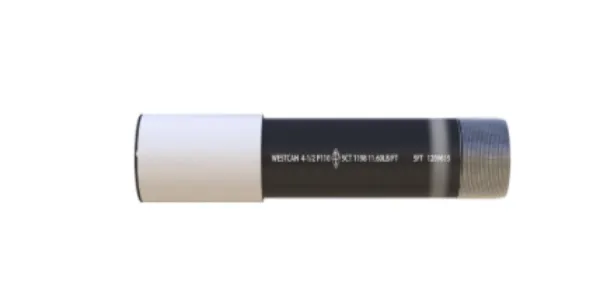Introduction
Pup joint is a commonly used spare part in industrial pipeline connection, widely used in oil, gas and other industries. API pup joint is a pup joint that meets the standards of the American Petroleum Institute (API 5CT), mainly used to connect two joints of oil pipes and casings. This article will introduce the definition, classification, specifications, materials, standards and application scenarios of API pup joint in detail.
Definition and classification of API 5CT pup joint
A pup joint is a casing, pipe or tubing that is shorter than a standard pipe string. Compared with standard length casing and tubing , the pup joint is shorter, and other dimensions and requirements are the same as tubing. API pup joints can be divided into tubing pup joints and casing pup joints. A tubing pup joint is a short tubing, and its length range is shorter than the tubing length range R1 in the API 5CT standard, and the length is generally 0.25 meters, 0.5 meters, 1 meter, 1.5 meters, etc. The casing pup joint is mainly used for downhole tubing adjustment and installation tools and various tubular components.

API pup joint specifications and sizes
API pup joints have various specifications and sizes, and can be produced and processed according to customer orders. The specifications of tubing range from 1.315 inches (33.4 mm) to 4-1/2 inches (114.3 mm), and the specifications of casing range from 4-1/2 inches (114.3 mm) to 20 inches (508 mm).
Common API pup joint specifications include lengths of 0.25 m, 0.5 m, 1 m, 1.5 m, etc., and outer diameters ranging from 1.315 inches to 4-1/2 inches. Pup joints also cover double male pup joints (PIN X PIN) and a variety of top processing methods, such as EUE (enhanced) and NUE (non-enhanced). In addition, the external thread types of pup joints include STC, LTC, BTC, and some special clearance threads, such as VAM TOP and NEW VAM, to meet different connection requirements and working environments.
API pup joint materials and standards
API pup joint materials mainly include J55, K55, N80, L80, P110, etc., each with specific applicable environments and pressure requirements. J55 and K55 are suitable for medium and low pressure environments, while N80 and L80 are suitable for medium and high pressure environments. P110 material is designed for high pressure environments. These pup joints must comply with API Spec 5CT/5B standards to ensure that their dimensions, materials, manufacturing processes, inspections and test methods meet industry requirements. In addition, its implementation standards include API interface-5CT, API interface-5B, and other related standards such as ASTM-A106-Gr.B, ASTM-A53, DIN, BS, JIS, EN, etc.
Manufacturing and quality control of API pup joints
The manufacturing process of API pup joints requires strict quality control to ensure its safety and reliability in use. The manufacturing process mainly includes the following steps:
Material selection: Select appropriate steel according to customer requirements and API standards.
Cutting and processing: Cut the steel into specified lengths and process the outer diameter and inner diameter.
Heat treatment: Improve the mechanical properties of the pup joint through heat treatment processes (such as quenching, tempering, etc.).
Thread processing: Process the threads according to API standards to ensure the accuracy and fit of the threads.
Detection and testing: Perform non-destructive testing (such as ultrasonic testing, magnetic particle testing, etc.) and mechanical property tests (such as tensile testing, impact testing, etc.) on the pup joint to ensure that it meets the requirements of API standards.
Surface treatment: Perform surface treatment (such as phosphating, spraying, etc.) on the pup joint to improve its corrosion resistance.
API pup joints, also known as pup joints, are widely used in the oil and gas industry for several critical applications:
Downhole Pipe Connections: Pup joints are used to connect tubing and casing joints, ensuring the integrity, sealing, and mechanical strength of the pipe column. These connections must withstand high pressures and complex operational conditions.
Downhole Tool Installation: In downhole operations, various tools and equipment need to be installed into the pipe column. Pup joints are utilized to adjust the position and depth of these tools, ensuring accurate execution of operational tasks.
Pipe Length Adjustments: Specific projects may require adjustments to the length of the pipe column based on downhole geological conditions and operational needs. Pup joints provide a flexible solution for quickly and precisely adjusting the total length of the pipe column.
Emergency Repairs: During downhole operations, if the pipe column experiences unexpected damage or requires urgent repairs, pup joints can be swiftly applied to ensure the continuity and safety of operations. This capability is crucial in reducing downtime and maintenance costs.
Special Threaded and Coupled Joints: Apart from standard pup joints, there are also specially designed types with unique threaded and coupled connections. These joints offer enhanced sealing performance and durability, suitable for specialized operational environments and project requirements.
API 5CT covers requirements for steel casing nipples with ODs from 4 1/2" to 20". It includes:
Materials and heat treatment
Threading, marking and handling
Dimensions, weight and drift
Tensile, impact and straightness testing
Hydrostatic verification
Full-length nondestructive testing
Conclusion
As a key component in industrial pipeline connections, API pup joints are widely used in the oil and gas industry. With various specifications and rich materials, they can meet different working environments and pressure requirements. Through strict manufacturing and quality control, API pup joints have shown excellent performance and reliability in downhole operations.






 English
English Español
Español بالعربية
بالعربية











 Phone :
Phone :  Whatsapp :
Whatsapp :  Email :
Email : 


